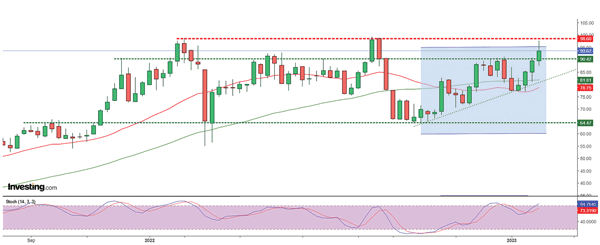By Frank O. Brannvoll, Brannvoll ApS, Denmark
January and the start of February saw the return of compliance buying of EUAs with some market speculators believing the latest changes will support the EU ETS to remain strong within the EU green deal.
The volatility of EUA prices has seen dramatic moves between EUR75 and back to highs at EUR97 without any specific news other than changing weather conditions and a relatively thin market.

EUA front-year contract, September 2021-January 2023
For 2023 Brannvoll ApS expects a range of EUR60-95, with an average of EUR82, which may overshoot towards the EUR100 mark if conditions are right.
The compliance buying by power producers and other market participants has to be completed by April. This trend will normally see a steady support of the market and speculators will often seek the opportunity to “ride the trend” unless major news arrives.
The emission levels for 2023 so far are 18 per cent lower than in 2022, when they were higher than the last five years.
Market awaiting CBAM impact
The market is still waiting for the carbon border adjustment mechanism (CBAM) to take effect in October 2023, amid other changes.
CBAM charges will be calculated based on “embedded emissions,” which refers to emissions occurring during manufacture, as well as indirect emissions. Where imported goods have been subject to carbon pricing regimes in their country of origin, only the difference between the price paid there and the price of EU-ETS carbon allowances will be paid. Payment of CBAM charges will be facilitated through the purchase of CBAM certificates.
Furthermore, under the latest changes the carbon reduction target was increased from 43 to 62 per cent in 2030. The linear reduction increased from 2.2 per cent to 4.3 per cent between 2024-27 and 4.4 per cent between 2028-30.
